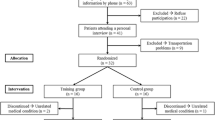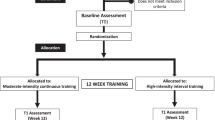Summary
The debilitating loss of function after a stroke has both primary and secondary effects on sensorimotor function. Primary effects include paresis, paralysis, spasticity, and sensory-perceptual dysfunction due to upper motor neuron damage. Secondary effects, contractures and disuse muscle atrophy, are also debilitating. This paper presents theoretical and empirical benefits of aerobic exercise after stroke, issues relevant to measuring peak capacity, exercise training protocols, and the clinical use of aerobic exercise in this patient population. A stroke, and resulting hemiparesis, produces physiological changes in muscle fibres and muscle metabolism during exercise. These changes, along with comorbid cardiovascular disease, must be considered when exercising stroke patients. While few studies have measured peak exercise capacity in hemiparetic populations, it has been consistently observed in these studies that stroke patients have a lower functional capacity than healthy populations. Hemiparetic patients have low peak exercise responses probably due to a reduced number of motor units available for recruitment during dynamic exercise, the reduced oxidative capacity of paretic muscle, and decreased overall endurance. Consequently, traditional methods to predict aerobic capacity are not appropriate for use with stroke patients. Endurance exercise training is increasingly recognised as an important component in rehabilitation. An average improvement in maximal oxygen consumption (V̇O2max) of 13.3% in stroke patients who participated in a 10-week aerobic exercise training programme has been reported compared with controls. This study underscored the potential benefits of aerobic exercise training in stroke patients. In this paper, advantages and disadvantages of exercise modalities are discussed in relation to stroke patients. Recommendations are presented to maximise physical performance and minimise potential cardiac risks during exercise.
Similar content being viewed by others
References
American Heart Association. Heart and stroke facts: 1995 statistical supplement. Dallas: American Heart Association, 1994
Thorn TJ, Epstein FH. Heart disease, cancer, and stroke mortality trends and their interrelations. An international perspective. Circulation 1994; 90 (1): (574–82)
Barnett HJ, Mohr JP, Stein BM, et al., editors. Stroke: pathophysiology, diagnosis, and management. New York: Churchill Livingstone, 1992
Gresham GE, Dawber TR. Residual disability in survivors of stroke. The Framingham study. N Engl J Med 1975; 293: (954–6)
WHO Task Force on stroke and other cerebrovascular disorders. Recommendations on stroke prevention, diagnosis, and therapy. Stroke 1989; 20: (1407–31)
Newman LB. Physical medicine and rehabilitation for stroke patients. Am Geriatr Soc 1967; 15: (111–28)
Duncan PW, Badke MB, editors. Stroke rehabilitation: the recovery of motor control. Chicago: Year Book Medical, 1987
Ragnarsson KT. Physiologic effects of functional electrical stimulation-induced exercises in spinal cord-injured individuals. Clin Orthop 1988; 126: (53–63)
Landin S, Hagenfeldt L, Saltin B, et al. Muscle metabolism during exercise in hemiparetic patients. Clin Sci Mol Med 1977; 53: (257–69)
Jakobsson F, Edstrom L, Grimby L, et al. Disuse of anterior tibial muscle during locomotion and increased proportion of type II fibers in hemiplegia. J Neurol Sci 1991; 105: (49–56)
Brooke MH, Engel WK. The histographic analysis of human muscle biopsies with regard to fiber types. Part 2: diseases of the upper and lower motor neuron. Neurology 1969; 19: (378–93)
Scelsi R, Lotta S, Lommi G, et al. Hemiplegie atrophy. Acta Neuropathol 1984; 62: (324–31)
Dietz V, Ketelsen U, Berge W, et al. Motor unit involvement in spastic paresis. J Neurol Sci 1986; 75: (89–103)
Booth FW, Gollnick PD. Effects of disuse on the structure and function of skeletal muscle. Med Sci Sports Exerc 1983; 15: (415–20)
Kasper CE, McNulty AL, Otto AJ, et al. Alterations in skeletal muscle related to impaired physical mobility: an empirical model. Res Nurs Health 1993; 16: (265–73)
Hertzer NR, Young JR, Beven EG, et al. Coronary angiography in 506 patients with extracranial cerebrovascular disease. Arch Intern Med 1985; 145: (849–52)
Rokey R, Rolak LA, Harati Y, et al. Coronary artery disease in patients with cerebrovascular disease: a prospective study. Ann Neurol 1984; 16: (50–3)
Di Pasquale G, Andreoli A, Pinelli G, et al. Cerebral ischemia and asymptomatic coronary artery disease: a prospective study of 83 patients. Stroke 1986; 17: (1098–101)
Di Pasquale G, Andreoli A, Grazi P, et al. Detection of silent myocardial ischemia in cerebrovascular patients by dipyridamole thallium myocardial imaging [abstract]. Stroke 1989; 20: (155)
Love BB, Grover-McKay M, Biller J, et al. Coronary artery disease and cardiac events with asymptomatic and symptomatic cerebrovascular disease. Stroke 1992; 23: (939–45)
Roth EJ. Heart disease in patients with stroke: incidence, impact, and implications for rehabilitation. Part 1: classification and prevalence. Arch Phys Med Rehabil 1993; 74: (752–60)
Chimowitz MI, Mancini GB. Asymptomatic coronary artery disease in patients with stroke. Stroke 1992; 23: (433–6)
Hamm LF, Leon AS. Exercise training for the coronary patient. In: Wenger NK, Hellerstein HK, editors. Rehabilitation of the coronary patient. New York: Churchill Livingstone, 1994
Clausen JP. Circulatory adjustments to dynamic exercise and effect of physical training in normal subjects and in patients with coronary artery disease. In: Sonnenblick EH, Lesch M, editors. Exercise and heart disease. New York: Grune & Stratton, 1977
Potempa K, Lopez M, Braun L, et al. Physiological outcomes of aerobic exercise training in hemiparetic stroke patients. Stroke 1995; 26: (101–5)
King JL, Guarracini M, Lenihan L, et al. Adaptive exercise testing for patients with hemiparesis. J Cardiopulm Rehabil 1989; 9: (237–42)
Monga T, Deforge D, Williams J, et al. Cardiovascular responses to acute exercise in patients with cerebrovascular accidents. Arch Phys Med Rehabil 1988; 69: (937–40)
Bachynski-Cole M, Cumming G. The cardiovascular fitness of disabled patients attending occupational therapy. Occup Ther J Res 1985; 5: (233–42)
Moldover J, Daum M. Cardiac stress testing of hemiparetic patients with a supine bicycle ergometer: preliminary study. Arch Phys Med Rehabil 1984; 65: (470–3)
Brinkmann J, Hoskins T. Physical conditioning and altered selfconcept in rehabilitated hemiplegie patients. Phys Ther 1979; 7: (859–65)
Bjuro T, Fugl-Meyer R, Grimby G, et al. Ergonomie studies of standardized domestic work in patients with neuromuscular handicap. Scand J Rehabil Med 1975; 7: (105–13)
McArdle W, Katch F, Katch V. Exercise physiology, energy, nutrition, and human performance. 2nd ed. Philadelphia: Lea & Febiger, 1986
Heath GW, Hagberg JM, Ehsani AA, et al. A physiological comparison of young and older endurance athletes. J Appl Physiol 1981; 51: (634–40)
Corcoran P, Jebsen R, Brengelmann G, et al. Effects of plastic and metal leg braces on speed and energy cost of hemiparetic ambulation. Arch Phys Med Rehabil 1970; 51: (69–77)
Astrand P, Rodahl, K. Textbook of work physiology. 3rd ed. New York: McGraw-Hill, 1986
Taylor H, Buskirk E, Henschel A. Maximal oxygen uptake as an objective measure of cardiorespiratory performance. J Appl Physiol 1955; 8: (73–8)
Mitchell JH, Sproule BJ, Chapman C. The physiological meaning of the maximal oxygen intake test. J Clin Invest 1958; 37: (538–47)
Astrand PO. Measurement of maximal aerobic capacity. Can Med Assoc J 1967; 96: (732–5)
Myers J, Walsh D, Buchanan N, et al. Can maximal cardiopulmonary capacity be recognized by a plateau in oxygen uptake? Chest 1989; 96: 1312–6
Myers J, Walsh D, Sullivan M, et al. Effect of sampling on variability and plateau in oxygen uptake. J Appl Physiol 1990; 46: (404–10)
Noakes T. Implications of exercise testing for prediction of the frequency of athletic performance: a contemporary perspective. Med Sci Sports Exerc 1988; 20: (319–30)
Cooper D, Weiler-Ravell D. Gas exchange response to exercise in children. Am Rev Respir Dis 1984; 129 Suppl.: S47–8
Wasserman K, Hansen J, Sue D, et al. Principles of exercise testing and interpretation. 2nd ed. Philadelphia: Lea & Febiger, 1994
Astrand I. Aerobic work capacity in men and women. Acta Physiol Scand Suppl 1960; 169: (1–9)
Hansen JE. Exercise instruments, schemes, and protocols for evaluating the dyspneic patient. Am Rev Respir Dis 1984; 129 (2 Pt 2): S25–7
Zhang Y, Johnson M, Chow N, et al. Effect of exercise testing protocol on parameters of aerobic function. Med Sci Sports Exerc 1991; 23: (625–30)
Whipp B, Davis J, Torres F, et al. A test to determine parameters of aerobic function during exercise. J Appl Physiol 1981; 50: (217–21)
Davis J, Whipp B, Lamarra N, et al. Effect of ramp slope on measurement of aerobic parameters from the ramp exercise test. Med Sci Sports Exerc 1982; 14: (339–43)
Cooper D, Weiler-Ravell D, Whipp B, et al. Aerobic parameters of exercise as a function of body size during growth in children. J Appl Physiol 1984; 56: (628–35)
Buchfuhrer M, Hansen J, Robinxon T, et al. Optimizing the exercise protocol for cardiopulmonary assessment. J Appl Physiol 1983; 55: (1558–64)
Fletcher BJ, Dunbar SB, Feiner JM, et al. Exercise testing and training in physically disabled men with clinical evidence of coronary artery disease. Am J Cardiol 1994; 73: (170–4)
Wannamethee G, Shaper AG. Physical activity and stroke in British middle aged men. Lancet 1992; 304: (597–601)
Wolf PA, D’Agostino RB, Belanger AJ, et al. Probability of stroke: a risk profile from the Framingham study. Stroke 1991; 22: (312–8)
Kiely DK, Wolf PA, Cupples LA, et al. Physical activity and stroke risk: the Framingham study. Am J Epidemiol 1994; 140: (608–20)
Roth EJ, Mueller K, Green D. Stroke rehabilitation outcome: Impact of coronary artery disease. Stroke 1988; 19: (42–7)
Rauramaa R, Salonen JT, Seppanen K, et al. Inhibition of platelet aggregability by moderate-intensity physical exercise: a randomized clinical trial in overweight men. Circulation 1986; 74: (939–44)
Kenney WL, Humphrey RH, Bryant CX, editors. ACSM’s guidelines for exercise testing and prescription. 5th ed. Philadelphia: Williams & Wilkins, 1995
Author information
Authors and Affiliations
Rights and permissions
About this article
Cite this article
Potempa, K., Braun, L.T., Tinknell, T. et al. Benefits of Aerobic Exercise After Stroke. Sports Med. 21, 337–346 (1996). https://doi.org/10.2165/00007256-199621050-00003
Published:
Issue Date:
DOI: https://doi.org/10.2165/00007256-199621050-00003




